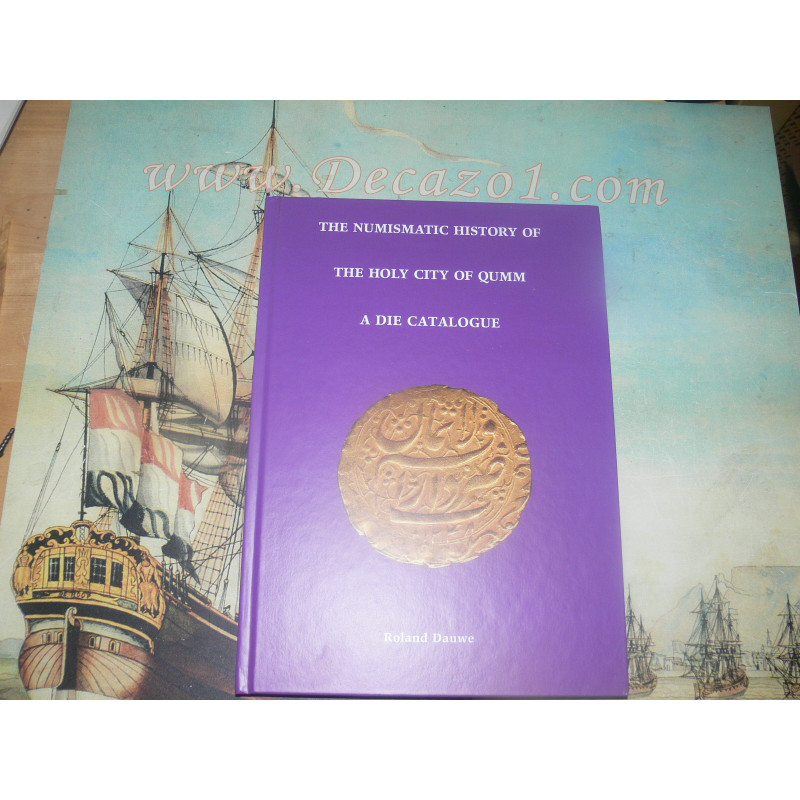



















Roland Dauwe
The Numismatic History of the Holy City of Qumm. A Die Catalogue.
Diestse Studiekring voor Numismatiek. S’Hertogenbosch. 2020. Hardcover. 84 p., 89 Plates.
For Condition, Index, and more details see photos.
Several years ago Roland Dauwe found it very strange that so few coins were recorded to be struck in Qumm, considering the importance of the town. Not only was Qumm, and still is, a sacred city for the Shi‘ite Muslims, but its location on the main road from Rayy (now part of Tehran) to Isfahan was of great strategic importance.
During his research it soon became clear that most Qumm coins, except for some Timurid issues, are all rare to extremely rare. In the meantime, he found that for most issues a very small number of dies were used, strengthening his conviction that a die corpus would be of great use for identifying the coins with partial dates or even those with the mint missing.
Buying Qumm coins whenever possible, he was able to build up a collection of more than 300 pieces. With that as a base and after visiting several coin cabinets and contacting other private collectors, it was possible to complete little by little his idea of the minting activity of Qumm.
The holy city of Qumm, located in the province of Jibal about 100 km south of Tehran, is a very old city and it is quite certain that several Sasanian rulers struck coins there and that a few very rare Arab-Sasanian coins were also struck there. Though the town had already been conquered by the Arabs in 22 AH, no pure Islamic coins were struck there before 245 AH. the starting point of a minting activity that would last for a millenium With a few exceptions, all the coins struck at Qumm are very scarce to extremely rare, probably the reason why only a very limited number of coins have been published in the past and that only a small number of specimens are to be found in most public and private collections.
The first Abbasid issue at Qumm, entirely composed of silver dirhams, was very short, from 245 to 250 AH Ca. 280 AH this was followed by a second and more important production,
this time mainly gold dinars, though a few silver dirhams were struck as well. The last date known to me is a dinar dated 325 AH. struck in the name of al-Radi.
Officially, the Abbasids lost western Iran to the Samanids after the invasion of Nasr II b Ahmad Though Samanid rule over Qumm was a very short one, a few dinars are known to have been struck there ca. 329-332 by Nasr II and by his son, Nuh I.
Next came the Buwayhids, a Shi'ite dynasty of Iranian origin. Since a die survey of the wayhid coinage has recently been published by Treadwell. we have a rather good idea of the coins struck at Qumm by four consecutive rulers between 337 and 403 AH. In the beginning, the issues were quite regular and were mainly composed of gold dinars. Later on, the issue of silver dirhams became more important while almost no gold was minted any more. At the end of the Buwayhid rule minting became more irregular, sometimes showing gaps of nearly ten years.
The following brief periods of Kakwayhid and Ghaznavid rule seem to have left no trace of minting activities at Qumm, but with the next dynasty, that of the Great Seljuqs, the town was again, though sporadically, used as a mint. We know that the first ruler, Toghril Beg, struck gold dinars at Qumm as early as 434 AH, but then there seems to be a gap of nearl) 50 years until the next issues of dinars of Barkiyaruq and Muhammad I. from ca. 485 to ca. 505 AH. Most Seljuq dinars of Qumm are badly struck, their weights showing a great fluctuation and generally far below the theoretical weight of the dinar. However, their coins are interesting in that they often bear the name of the local governor.
Though the city suffered much from the invasion of Iran by Timur, it remained one of the minting places of Timur and his successors. Both pre- and post-reform coins, with the name of the Chagatayid Mahmud, are known to have been struck by Timur, but It was under his son Shahrukh that Qumm had the greatest minting production in its history. The tankïis of that ruler are indeed the only coins of Qumm that are not scarce, specially those of his 5* issue that started in 827/8 AH.
Weight: 1.350 kg. (packaging included)
Combined shipping
After registration (Important) the system automatically calculates the thickness and weight of every letter and gives you the rate for your Country. (If the combined order becomes to thick or heavy for a registered letter by PostNL, you automaticly see the rate for a parcel in your shoppingcart.)
Shipping is based on a 2 kg registered letter/parcel by PostNL, up to 2 kg no extra shipping costs if the books fit in the same letter/parcel.
Europe only: If its cheaper, we ship with DPD parcels (A 10 kg parcel often costs a few Euros more as a 2 kg parcel by PostNL, the standard shipping company) you will get a refund if you paid to much postage!
Shipping Refunds will be given by Bank or PayPal (The system cann't do this automatcally). Look for details under Shipping & Delivery in the Top Bar.
Combined shipping rules:
You have to combine all your purchases in one order, otherwise the system will see the purchases as seperate orders and start again with the basic rate for a 2 kg registered letter/parcel.
If you accidentally place more orders, we will recalculate the postage and give you a refund. We always ship for the lowest possible costs!
We ship Worldwide, if you cann't register or place your order, please contact us by e-mail: decazo1@hotmail.com